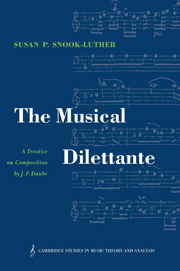Book contents
- Frontmatter
- Contents
- Foreword
- Translator's preface
- Introduction
- THE MUSICAL DILETTANTE: A TREATISE ON COMPOSITION (1773)
- Preface
- 1 Harmony in general
- 2 The three different motions of the voices
- 3 Combining two voices
- 4 Combining three voices
- 5 Combining four voices
- 6 Composition in five and more parts
- 7 Variation
- 8 Imitation
- 9 Canon
- 10 Simple fugue
- 11 Double counterpoint
- 12 Double fugue
- Bibliography
- Index
8 - Imitation
Published online by Cambridge University Press: 15 October 2009
- Frontmatter
- Contents
- Foreword
- Translator's preface
- Introduction
- THE MUSICAL DILETTANTE: A TREATISE ON COMPOSITION (1773)
- Preface
- 1 Harmony in general
- 2 The three different motions of the voices
- 3 Combining two voices
- 4 Combining three voices
- 5 Combining four voices
- 6 Composition in five and more parts
- 7 Variation
- 8 Imitation
- 9 Canon
- 10 Simple fugue
- 11 Double counterpoint
- 12 Double fugue
- Bibliography
- Index
Summary
Imitation has to do with artificial composition. In the discussion of two-part composition we already have demonstrated how one voice could imitate the other, and this has also been done with regard to the second type of three-part writing. The instruction on composition in four, five, and more parts likewise demonstrates its value. Imitation is indispensable in music. Nothing good in either melody or harmony can be accomplished without it. From imitation flows natural beauty. It unites art with nature. One can conveniently divide it into two classes. The first concerns only the initial or main melody of a single voice, and how this should be worked out in a piece by means of imitation. This is not to be spoken of here, however. The second class shows how to arrange the harmony so as to give rise to various imitations which are carried out by a few motives of either the main melody or the inner voices. The present discussion will characterize this class.
Imitation which occurs throughout the harmony is likewise divided into two types, the first of which consists of similar [i.e., real] imitation. This takes place when a motif from the main melody is either repeated with the same tones in an inner part, or imitated in another key. This type concerns artificial pieces, especially canons and fugues. The other type results when a melodic motif is imitated rather dissimilarly [i.e., tonally], but yet so that the key may not modulate.
- Type
- Chapter
- Information
- The Musical DilettanteA Treatise on Composition by J. F. Daube, pp. 144 - 156Publisher: Cambridge University PressPrint publication year: 1992



